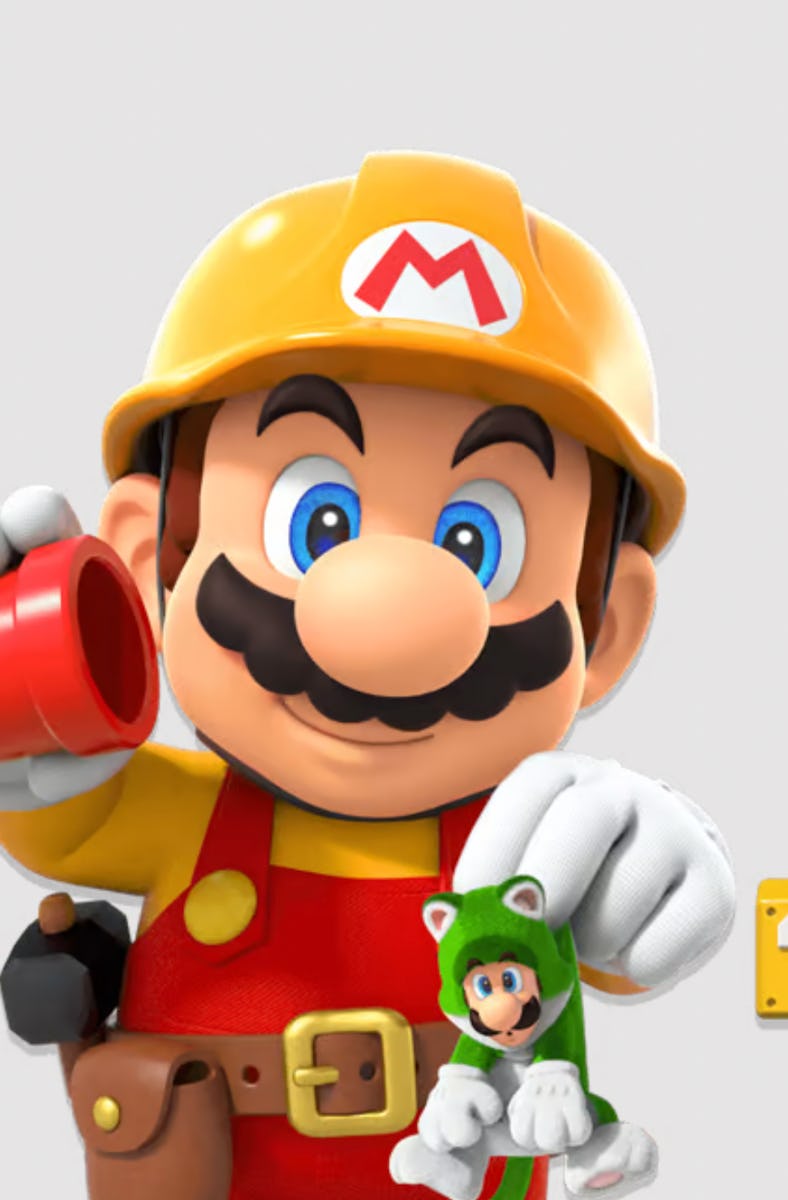5 Years Later, Mario Maker 2 Reveals a Quiet Battle Between Nintendo and its Fans
The beloved series could be so much more.

When it comes to protecting intellectual property, few companies are as notorious as Nintendo, which has never seen a fan-game it couldn’t strike down. Infamously, game developers at Nintendo aren’t allowed to modify or create new characters within the Mario universe, and if Mario pops up somewhere beyond those first-party games, the plumber’s appearance comes with rules.
It’s wild, then, that a series like Mario Maker, which gives players the freedom to build their own 2D platforming levels, exists at all. And after the onslaught of troll and glitch levels that players built with the first Mario Maker, it’s incredible that Nintendo bothered with a sequel. But that’s exactly what happened with the release of Super Mario Maker 2 for Nintendo Switch on June 28, 2019.
Mario Maker 2 is much more robust than the original, but still can’t compete with what fans are doing with unofficial ROMs.
Five years later, Super Mario Maker 2 has sold nearly 9 million copies, despite the fact that it’s been years since the game got a significant update. The last one came in 2020, when Nintendo took the opportunity to add new power-ups, like the frog suit; alongside much-needed quality of life additions, like giving players the ability to bunch levels together in a “world.” Updates like these made Mario Maker 2 far more robust than the first game, but compared to what fans could do in ROM-hacks, both titles are limited. Players have kept Mario Maker 2 alive, however, in part because it’s the only safe way to share levels with the public.
It’s worth noting that Mario Maker 2 still gets some updates, just nothing that adds new features. Five months ago, Nintendo quietly “made adjustments to make for a more pleasant gaming experience,” according to the nondescript patch notes. Hardcore players know the real deal, though. Historically, if Nintendo adjusts Mario Maker out of the blue, it’s likely to get rid of glitches. Incidentally, mere months before Mario Maker 2’s vague update, a speedrunning event saw a group of players showing off their extensive knowledge of in-game glitches that hadn’t been patched out yet. While it’s uncertain if this sudden 2024 patch addressed these specific glitches, it’s notable that the speedrunners urged people to download the levels while they could. With that much visibility, Nintendo pulling the levels was guaranteed. Here, we see the central tension of Mario Maker in a nutshell: hardcore players want to make impressive levels for everyone to enjoy, but Nintendo is intolerant when it comes to players meddling with its games.
Will we ever get a Zelda Maker game?
It’s unclear if Nintendo will ever follow up Mario Maker 2 and use the series as a framework for other classic 2D titles that could easily lend themselves to fan games. All the same, the legacy of Mario Maker’s user-friendly digital playground lives on. Most notably, the series inspired a genre of other accessible “Maker” games. Some of these games come across as a response to Nintendo’s unwillingness to expand on Mario Maker’s successes for more of its classic series, like Zelda. Beloved as it may be, however, Mario Maker has suffered the fate as other games of that era, which tried to levy the power of user-generated content. Like Sony’s Dreams, it never became a phenomenon on the level of Roblox. But this reality has less to do with the games, which were top-notch, than it does with Nintendo’s doomed walled garden on the Wii U, a platform with a poor online network compared to its competitors. The Switch might be a more popular console, but it still has its limits.
It’s a shame. Mario is already a household name, but he’s exploded even further in the mainstream’s consciousness after Nintendo’s record-breaking animated movie and its real-world theme park. However unlikely, handing Mario over to the people on a less restricted platform, still seems like a recipe for success. Failing that, and in lieu of a new Mario game altogether, it’s disappointing that Mario Maker 2 hasn’t gotten the Mario Kart 8 treatment of endless content updates.
Nintendo will probably release a new Mario Maker game for the upcoming Switch 2.
Still, Mario Maker 2 and its celebration of the legendary platforming series lives on. This year, players raced against time in the hopes of clearing 80,000 unbeaten levels in the first Mario Maker on the Wii U before Nintendo could permanently pull the plug on the game’s servers. The push carried over to Mario Maker 2, where hardcore players can say they’ve defeated every course created in 2019. The enormity of the undertaking in both games isn’t purely about having a staggering number of levels to clear. The challenge lies in the fact that these levels are likely unbeaten for a reason. Perhaps the creator concocted an infuriating “Kaizo” level that requires pixel-perfect reflexes the average player doesn’t have. Sometimes, participants brushed up against levels that were deliberately constructed to be impossible thanks to the help of glitches. The scale keeps expanding, too: as word of the effort spreads, more people are playing both Mario Maker games and ultimately adding more levels to the absurd pile.
Mario Maker 2 still has time left on the clock, though with a Switch successor on the horizon, those days might be numbered. For now, the sequel remains a testament to Nintendo’s unusual approach to game design, which places Mario Maker 2 alongside playful experiments like Mario Paint and the Nintendo Labo. These are concoctions that do more than entertain the player: they stoke creativity without risking a Nintendo copyright takedown. Above all, Mario Maker is a testament to what’s possible when Nintendo lets loose and allows players to define their own fun.